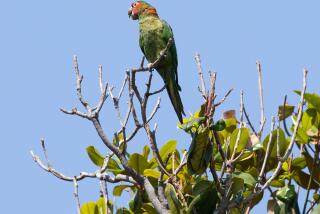London Unleashes Air Raids to Banish Bothersome Pigeons
- Share via
LONDON — Early on a crisp morning, while most of the capital sleeps, an elite fighting force rids the city of vermin.
Buzz, a 2-year-old Harris hawk, flies high above Westminster Abbey, the Houses of Parliament and other landmarks on the lookout for one of the greatest scourges of modern London -- pigeons.
Buzz and his handler, Roger Polley, rise before 4 a.m. three days a week to climb to the top of the Treasury building, where Buzz is set free. His circling presence is enough to scare off recalcitrant pigeons.
“It’s like having a tiger in your front room. You’re not going to hang around to see if it can catch you, and you are not going back in to see if it’s still there,” Polley said.
Falconry -- the hunting of wild quarry using trained birds of prey -- has been a sport in Europe for centuries, but only in recent years have canny falconers thought of turning their hobby into a business.
City officials say millions of pigeons in London are disease-ridden and have no respect for statues and historic buildings, leaving a collective calling card that costs thousands of dollars to remove.
Their growing numbers led City Hall to revoke the license of the last pigeon-feed seller in Trafalgar Square last year, ending a decades-old tourist tradition.
Polley’s boss, David Van Vynck, said his family falconry fell into the pest control business while displaying birds at a country fair about 10 years ago.
“A local baker saw us with the birds and asked us if we could scare away sparrows from its bakery. We were the only ones doing it at first,” he said.
“Although falconry is a sport that has been around since medieval times, the actual use of birds in this way to deter nuisance species is a modern-age phenomenon.”
Several falconries are now competing for business in London. Yearly contracts to keep dozens of sites around the capital pigeon-free -- such as Downing Street, where the prime minister lives -- are worth up to $65,000 each.
Some animal rights activists complain that the hawks often kill their prey rather than simply scare them away.
But van Vynck said a predatory bird couldn’t kill more than a bird a day. Instead, he said, their task is to “change the patterns of the pigeons who are creatures of habit. The Harris hawk is an excellent tool for removing pigeons from areas that we couldn’t otherwise get to.”
Richard Lewis, facilities manager for the newly refurbished Treasury building, said the government had enlisted the falconers because they wanted a humane solution.
“The alternatives are shooting them or poisoning them, neither of which are acceptable these days,” Lewis said. Falcons are “the natural way of doing things.”
The van Vynck falconry has 20 Harris hawks and 20 other falcons used for traditional hunting and display shows.
The hawks, worth $450 to $600 each, are taken to various sites around London, including train stations and parks
The falconry’s seven handlers develop a close relationship with the birds. Polley named his hawk after its habit of zooming in from behind and knocking his handler on the head, or “buzzing” him, when coming in to land on his arm. Thankfully, Buzz has grown out of the habit.
For Polley, a former factory worker who became a trained hawker two years ago, his job -- even with its early hours -- is one of the best in the world.
“Look at this view,” he said, gazing at the sun rising behind the Houses of Parliament. “Not everybody gets that for their office.”
More to Read
Sign up for Essential California
The most important California stories and recommendations in your inbox every morning.
You may occasionally receive promotional content from the Los Angeles Times.













